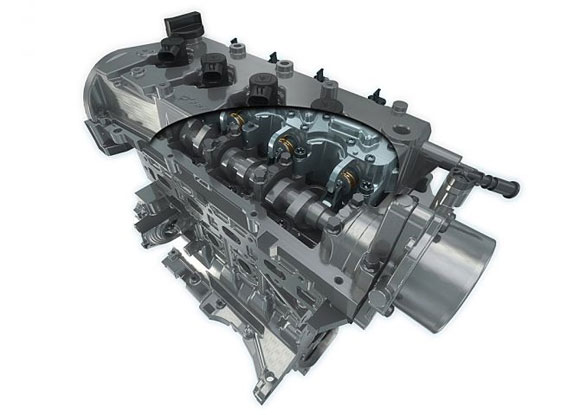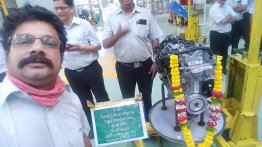If you have a love for the engine, the word Multijet should make your heart beat faster. Well, it's the award winning engine that's doing all the thermodynamics under the bonnet of the Swift, Palio, Indica Vista and 500. GM could use this engine in the future, and all of the Indica's and Indigo's in the future will latch on to this technology, not to mention the ever-enlarging Fiat line up.
A technology that will compliment Fiat's already-fuel efficient engines, has been introduced by Fiat at this year's Geneva Motor Show. It's termed Multiair technology is similar to a VTEC or VVTi, which deals with variable valve timing for better engine response and lower fuel consumption/emissions.
The Multiair range promises a 10 percent increment in horsepower, a 15 percent boost in low-rpm torque and a 10 percent leap in fuel efficiency and carbon emissions. Sounds good.
The Multiair technology will first be implemented on Fiat 1.4 16v FIRE engine. You guessed it- It's the same engine manufactured at Fiat's Ranjangoan plant.
Press Release
|
Fiat Multiair: The Ultimate Air Management Strategy GENEVA, Switzerland, 4 March, 2009 - Fiat Group and Fiat Powertrain Technolgy unveiled its new air management technology 'Multiair' at the Geneva Motor Show. Multiair is an electro-hydraulic system of engine valves for dynamic and direct control of air and combustion, cylinder by cylinder and stroke by stroke. Thanks to a direct control of the air through the intake engine valves without using the throttle, Multiair helps reducing fuel consumption; and pollutant emissions are likewise reduced through combustion control. The Fiat Multiair Technology: some history In the last decade, the development of the Common Rail technology for Diesel engines marked a breakthrough in the passenger car market. To be competitive also in the field of gasoline engines, Fiat Group decided to follow the same approach and focus on breakthrough technologies. The aim was to provide customers with substantial benefits in terms of fuel economy and fun-to-drive while maintaining the engine intrinsic comfort characteristics, based on a smooth combustion process and on light structures and components. The key parameter to control Diesel engine combustion and therefore performance, emissions and fuel consumption is the quantity and characteristics of the fuel injected into cylinders. That is the reason why the Common Rail electronic Diesel fuel injection system was such a fundamental breakthrough in Direct Injection Diesel engine technology. The key parameter to control gasoline engine combustion, and therefore performance, emissions and fuel consumption, is the quantity and characteristics of the fresh air charge in the cylinders. In conventional gasoline engines the air mass trapped in the cylinders is controlled by keeping the intake valves opening constant and adjusting upstream pressure through a throttle valve. One of the drawbacks of this simple conventional mechanical control is that the engine wastes about 10% of the input energy in pumping the air charge from a lower intake pressure to the atmospheric exhaust pressure. A fundamental breakthrough in air mass control, and therefore in gasoline engine technology, is based on direct air charge metering at the cylinder inlet ports by means of an advanced electronic actuation and control of the intake valves, while maintaining a constant natural upstream pressure. Research on this key technology started in the 80's, when engine electronic control technologies reached the stage of mature technologies. At the beginning world-wide research efforts were focused on the electromagnetic actuation concept, following which valve opening and closing is obtained by alternatively energizing upper and lower magnets with an armature connected to the valve. This actuating principle had the intrinsic appeal of maximum flexibility and dynamic response in valve control, but despite a decade of significant development efforts the main drawbacks of the concept - its being intrinsically not fail-safe and its high energy absorption - could not be fully overcome. At this point most automotive companies fell back on the development of the simpler, robust and well-known electromechanical concepts, based on the valve lift variation through dedicated mechanisms, usually combined with cam phasers to allow control of both valve lift and phase. The main limitation of these systems is low flexibility in valve opening schedules and a much lower dynamic response; for example all the cylinders of an engine bank are actuated simultaneously thereby excluding any cylinder selective actions. Many similar electromechanical valve control systems were then introduced over the past decade. In the mid 90's Fiat Group research efforts switched to electro-hydraulic actuation, leveraging on the know-how gained during the Common Rail development. The goal was to reach the desired flexibility of valve opening schedule air mass control on a cylinder-by-cylinder and stroke-by-stroke basis. The electro-hydraulic variable valve actuation technology developed by Fiat was selected for its relative simplicity, low power requirements, intrinsic fail safe nature and low cost potential. The Fiat Multiair Technology: how it works The operating principle of the system, applied to intake valves, is the following: a piston, moved by a mechanical intake cam, is connected to the intake valve through a hydraulic chamber, which is controlled by a normally open on/off Solenoid Valve. When the Solenoid Valve is closed, the oil in the hydraulic chamber behaves like a solid body and transmits to the intake valves the lift schedule imposed by the mechanical intake cam. When the solenoid valve is open, the hydraulic chamber and the intake valves are de-coupled; the intake valves do not follow the intake cam anymore and close under the valve spring action. The final part of the valve closing stroke is controlled by a dedicated hydraulic brake, to ensure a soft and regular landing phase in any engine operating conditions. Through Solenoid Valve opening and closing time control, a wide range of optimum intake valve opening schedules can be easily obtained. For maximum power, the Solenoid Valve is always closed and full valve opening is achieved following completely the mechanical cam, which was specifically designed to maximize power at high engine speed (long opening time). For low-rpm Torque, the Solenoid Valve is opened near the end of the cam profile, leading to early intake valve closing. This eliminates unwanted backflow into the manifold and maximizes the air mass trapped in the cylinders. In engine part load, the Solenoid Valve is opened earlier causing partial valve openings to control the trapped air mass as a function of the required torque. Alternatively the intake valves can be partially opened by closing the Solenoid Valve once the mechanical cam action has already started. In this case the air stream into the cylinder is faster and results in higher in-cylinder turbulence. The last two actuation modes can be combined in the same intake stroke, generating a so-called "Multilift" mode, that enhances turbulence and combustion rate at very low loads. The Multiair Technology Benefits The Multiair Technology potential benefits for gasoline engines exploited so far can be summarized as follows: - Maximum Power is increased by up to 10% thanks to the adoption of a power-oriented mechanical cam profile - Low-rpm Torque is improved by up to 15% through early intake valve closing strategies that maximize the air mass trapped in the cylinders. - Elimination of pumping losses brings a 10% reduction of Fuel Consumption and CO2 emissions, both in Naturally Aspirated and Turbocharged engines with the same displacement - Multiair Turbocharged and downsized engines can achieve up to 25% Fuel Economy improvement over conventional Naturally Aspirated engines with the same level of performance - Optimum valve control strategies during engine warm-up and internal Exhaust Gas Recirculation, realized by reopening the intake valves during the exhaust stroke, result in emissions reduction ranging from 40% for HC / CO to 60% for NOx - Constant upstream air pressure, atmospheric for Naturally Aspirated and higher for Turbocharged engines, together with the extremely fast air mass control, cylinder-by-cylinder and stroke-by-stroke, result in a superior dynamic engine response Application of the Multiair Technology to FPT Engines The first world-wide application of the Multiair technology will be the Fire 1400cc 16V Naturally Aspirated and Turbocharged engines. The second application is a new Small Gasoline Engine (SGE - 900cc Twin-cylinder) where cylinder head design has been specifically optimized for the Multiair actuator integration. Here again, there will be both a Naturally Aspirated and a Turbocharged version. A specific Turbocharged engine version will be bi-fuel (gasoline- CNG). Thanks to radical downsizing, the Turbocharged Small Gasoline Engine achieves Diesel-like CO2 emission levels, which are further reduced in its Natural Gas version with CO2 emissions lower than 80 g/km in many vehicle applications. |













